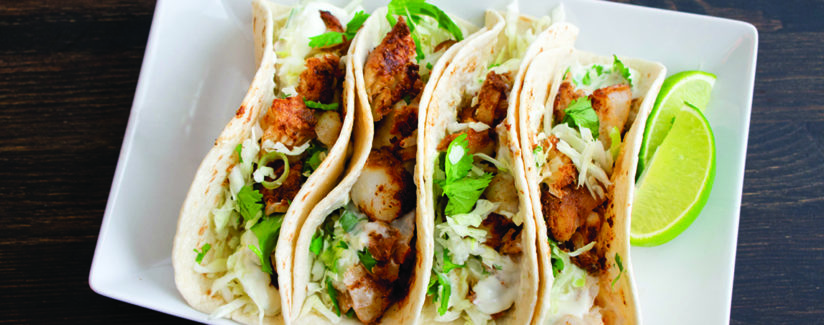
What Do Farmed Fish Eat?
Have you ever wondered what fish eat? In aquaculture production systems, fish are provided with essential nutrients from their feed to stay healthy and grow efficiently. We reached out to Dr. Stefanie Colombo from Dalhousie University in Halifax, Nova Scotia, to get the scoop on fish feed.
What does farmed fish feed look like?
 Dr. Colombo: “The feed looks very similar to the kibble you would feed to your pet dog or cat. It is an extruded pellet. We actually eat lots of extruded foods – think breakfast cereals, like puffed corn or corn pops. The process is the same.”
Dr. Colombo: “The feed looks very similar to the kibble you would feed to your pet dog or cat. It is an extruded pellet. We actually eat lots of extruded foods – think breakfast cereals, like puffed corn or corn pops. The process is the same.”
What are the primary ingredients?
Dr. Colombo: “The ingredients can vary, what is most important is that the nutrients in the ingredients meet the requirements of the fish. So, the ingredient itself is not as important as the nutrient it supplies. For example, Atlantic salmon need about 50% protein and 25% fat. This can come from different ingredients, but, some of the most common ingredients are based from corn, poultry, canola, soy, wheat and fish.”
People seem to be concerned about fish meal and fish oil in farmed fish diets. Why is this a concern?
Dr. Colombo: “Using fish meal and fish oil in diets for farmed fish is necessary, but there is concern because these ingredients are sourced from wild fish populations, such as herring, sardines, anchovies, and menhaden. A majority of fisheries have been at their sustainable limits for the past twenty years – they are not declining – but they are not growing either. This is a concern as the human population grows and we need more healthy protein and fats to support our nutritional needs. Aquaculture is helping to meet our seafood demand (60% of our seafood will be from aquaculture by 2030), but when it depends on wild fish, this is a constraint on the fisheries and on the ability for aquaculture to meet the needs of the human population. We are getting more efficient at making fish meal and oil from what we already have, as opposed to catching more fish – for example, the heads and tails of fish that we don’t eat are a perfect source of fish meal and oil for farmed fish. But it is likely that in the future, the aquaculture industry will not need fish meal or oil at all to produce healthy, high quality farmed fish.”
How can we decrease the amount of fish meal and fish oil in their diets?
Dr. Colombo: “Researchers and the aquaculture feed industry have made strides in reducing the levels of fish meal and fish oil that are included in the diet. There are hundreds, if not thousands, of studies that have tested new ingredients that can be used for growing different farmed fish species. Again, the important thing is providing the correct nutrients, more than it is about the ingredients. Fish meal and oil have decreased in commercial diets from about 70% of the diet to about 25% of the diet. Plant-based ingredients have been used to supply some of the protein and fat to replace fish meal and oil. Still, some fish meal and oil need to be used, because they supply nutrients that are not made by plants – like the omega-3’s (eicosapentaenoic acid – EPA, and docosahexaenoic acid – DHA), which are needed for fish health. Research efforts continue so that we can feed completely vegan-diets to any farmed fish species that does not compromise their health and well-being.”
Do different varieties of fish eat different foods? If so, how different?
Dr. Colombo: “Yes, different species of fish have different nutrient requirements. Some fish are naturally carnivores – they eat other fish – like salmon, rainbow trout, halibut, tuna. Some fish are naturally herbivores – they only eat plants – like carp. Some fish are omnivores – eat both plant and animal matter – like tilapia, catfish. The nutrient requirements of the species, and what they are able to digest and absorb, helps to determine the types of ingredients that can be used in their diets.”
Can some fish be organic? Do organic fish eat different foods?
Dr. Colombo: “Yes, farmed fish can be raised organically. Their feed is an important part of the organic regulations. The feed must be compatible and comparable to the species’ natural diet. Where fish meal and fish oil must be used, there are preferences in the Canadian Guidelines about the source of fish meal and oil that is used, such as using trimmings (i.e., heads and tails) from organically raised fish for human consumption or from wild caught fish that were already caught for human consumption. For salmon, there are restrictions on the type of pigments that are included in the feed, they must be from a natural source. They are also raised organically because they are raised without use of antibiotics, with more focus on preventative methods for rearing.”
Learn more about how fish are raised.
Farmed fish eat feed that has been developed to provide the nutrients they need. Different species have different nutrient requirements. Most feed contains fish meal or oil and researchers are developing many new options for feed.


























